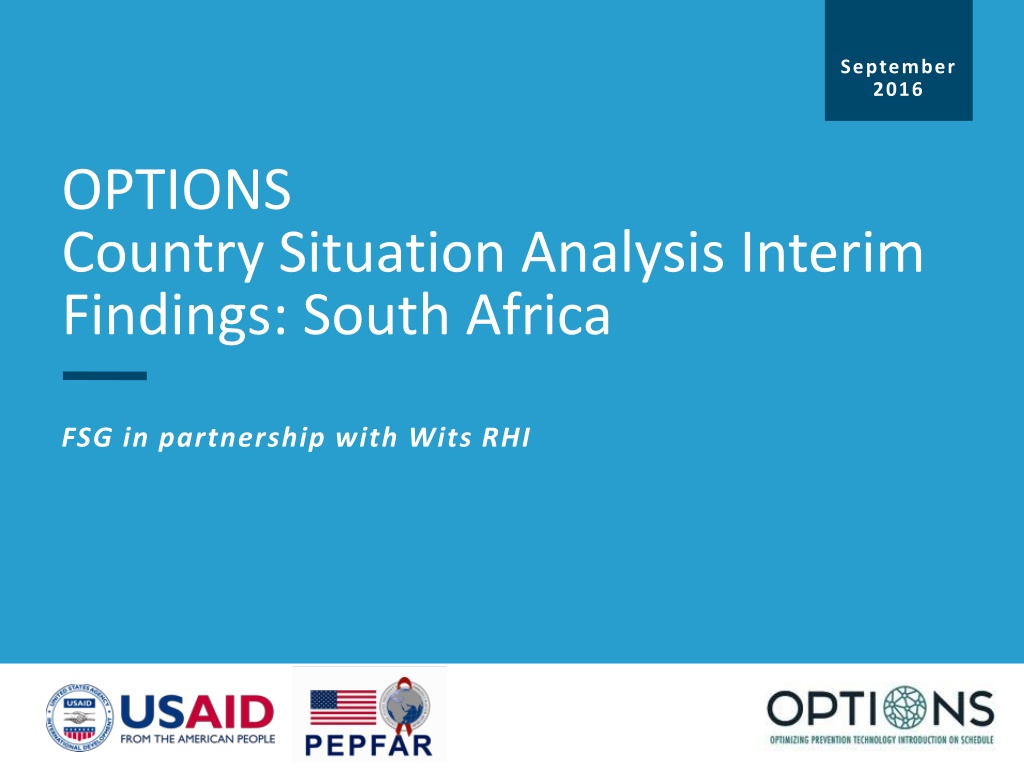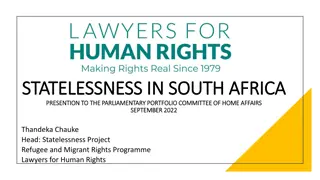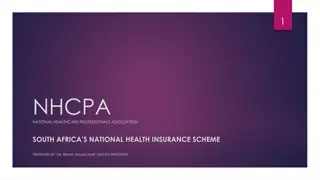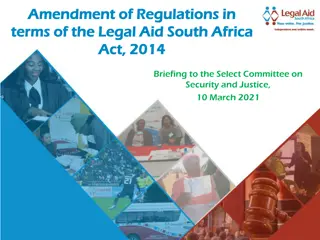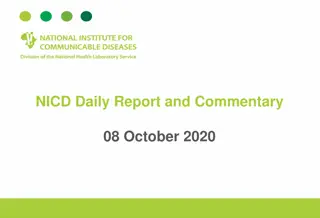South Africa Situation Analysis Interim Findings
This document presents interim findings from the OPTIONS situation analysis for South Africa conducted by FSG in partnership with Wits RHI. The analysis aims to provide insights and recommendations to expedite access to new ARV-based HIV prevention products, focusing on priority areas and populations. The document outlines the objectives, aims, and working approach of the OPTIONS Consortium to support the introduction and sustainable access to these products, emphasizing evidence-based strategies, regulatory support, implementation science, and health systems strengthening.
Download Presentation

Please find below an Image/Link to download the presentation.
The content on the website is provided AS IS for your information and personal use only. It may not be sold, licensed, or shared on other websites without obtaining consent from the author.If you encounter any issues during the download, it is possible that the publisher has removed the file from their server.
You are allowed to download the files provided on this website for personal or commercial use, subject to the condition that they are used lawfully. All files are the property of their respective owners.
The content on the website is provided AS IS for your information and personal use only. It may not be sold, licensed, or shared on other websites without obtaining consent from the author.
E N D
Presentation Transcript
September 2016 OPTIONS Country Situation Analysis Interim Findings: South Africa FSG in partnership with Wits RHI
OPTIONS Introduction One of five cooperative agreements awarded by USAID with PEPFAR funding through Round Three of the Annual Program Statement (APS) for Microbicide Research, Development, and Introduction. KENYA The OPTIONS Consortium objective is to provide targeted support to help expedite and sustain access to new ARV-based HIV prevention products in countries and among populations where most needed. ZIMBABWE OPTIONS Consortium Members SOUTH AFRICA 2 APRIL 2016
OPTIONS Consortium Aims OPTIONS can provide targeted support across its four project aims: AIM 1 AIM 2 AIM 3 AIM 4 Develop evidence- based business cases and a coordinated investment strategy for ARV- based prevention product introduction to ensure timely global, national and private sector action on priority areas Support country levelregulatory approval, policy development, program planning, marketing and implementation strategies for ARV- based prevention product introduction Facilitate and conduct implementation science (IS) to advance the introduction of and access to microbicides and ARV-based prevention technologies Provide technical assistance and support for health systems strengthening (HSS)with rapid use of data to identify and address implementation bottlenecks throughout the value chain 3 APRIL 2016
OPTIONS How We Work OPTIONS is not a service delivery project; we apply systems thinking to support and accelerate product introduction Our support is flexible and is designed to be responsive to national country priorities and plans and will be guided by national leadership In addition to Wits RHI, our consortium is able to bring multi-disciplinary expertise to the effort to introduce female-controlled HIV prevention products in South Africa We are taking significant steps to ensure we do not replicate existing or ongoing work our mission is to fill gaps and help answer key questions as outlined by the national government, the USAID country mission, and other key local stakeholders 4 APRIL 2016
About the Situation Analysis This document includes interim findings from the OPTIONS situation analysis for South Africa, completed by FSG with significant input and consultation from Wits RHI The situation analysis aims to take a comprehensive and robust approach to assessing the state of the field for PrEP in South Africa, including opportunities and resources as well as gaps and expected challenges The situation analysis serves multiple purposes: it provides a basis for country consultations and stakeholder engagement, it serves as a tool to clarify the roles, activities and investments needed for the successful roll-out of PrEP, and it will inform the development of the OPTIONS investment cases for PrEP This document reflects findings primarily from secondary research, with input from country consultations conducted by Wits RHI additional consultations are forthcoming and will contribute additional detail and nuance to this analysis This is designed as a livingdocument, to serve as a repository for information regarding the situation of PrEP in South Africa to be updated on an ongoing basis as additional information becomes available and progress is made towards the roll-out of PrEP If you have any updates, additional information, or follow-up questions regarding this content here, please email Neeraja Bhavaraju at neeraja.bhavaraju@fsg.org 5 APRIL 2016
Executive Summary South Africa s regulatory and healthcare delivery bodies are in progress on the roll-out of oral PrEP to priority populations. However, a number of outstanding questions remain. The National Department of Health (NDoH) has voiced support for PrEP as part of the country s comprehensive prevention package. The NDoH has initiated the development of treatment and implementation guidelines following the registration of Truvada as PrEP by the Medicines Control Council (MCC). In March 2016, the government announced that it would introduce PrEP as part of a broader combination prevention and treatment program for sex workers. The National Test and Treat (T&T) and PrEP TWG, led by the NDoH, developed the Guidelines for Expanding Combination Prevention and Treatment Options for Sex Workers: Oral Pre-Exposure Prophylaxis (PrEP) and Test and Treat (T&T) The strongest existing channels for HIV care delivery to target populations are currently those for men who have sex with men (MSM) and sex workers (SW). The newly launched National Sex Worker HIV Plan for 2016-2019 provides for immediate ART to all HIV-positive SW and offering PrEP to HIV-negative SW. The NDoH launched the provision of PrEP in 11 SW sites (existing donor-funded and demonstration project sites) on 1 June 2016. The adolescent girls and young women (AGYW) PrEP TWG was formed in March 2016. This group is working on an in-depth landscape analysis focused specifically on program research agendas and evidence collection, with the aim to determine what gaps will remain across AGYW PrEP programs. Remaining questions for exploration include: plans to introduce PrEP for high-risk adolescent girls and young women and the potential to use less expensive generic forms of Oral PrEP (e.g., generic TDF / FTC, which has been filed with regulatory authorities) A number of ongoing demonstration projects, studies and other programs in South Africa will inform these questions, including: DREAMS and HPTN082, both focused on adolescent girls and young women 6 APRIL 2016
Current State of HIV in South Africa Context 6.8 million people estimated to be living with HIV1,making South Africa the country with the highest HIV burden in the world Prevalence rate in adults is 15-49 18.9%2 The number of annual new infections is estimated at 469,000.3 While new infections have been reduced by about a third since 2004, incidence is rising in certain populations, particularly among adolescent girls and young women (AGYW) New infections for those age 15 49 years is 1.7 times higher in women than in men; among youth 15-24 it is over 4 times higher Trend The overall trend of HIV incidence is positive, however it masks differences amongst demographic groups. Demographics AGYW are disproportionally affected by HIV: they comprise ~25% of new infections and are more than twice as likely to be HIV positive as male peers3 Geography Prevalence varies sizably between provinces, from 16.9% in KwaZulu- Natal to 5% in Western Cape3 Prevalence is highest in medium and large urban areas, although data for rural settings is poor/incomplete HIV Prevalence by district, displayed as percent of general population 15-49 (2012) Source: UNAIDS Epidemiological Fact Sheet on HIV and AIDS Source: SA National HIV Prevalence and Behaviour Survey, 2012 Source: SA National HIV Prevalence and Behaviour Survey, 2012 Sources: (1) Total estimate PLHIV: SANAC, http://sanac.org.za/news/item/261-hiv-infection-is-still-largely-political, (2) Adult Prevalence: UNAIDS, http://www.unaids.org/sites/default/files/epidocuments/ZAF.pdf, (3) South African National HIV Prevalence, Incidence and Behaviour Survey, 2012, http://www.hsrc.ac.za/en/research-data/ktree-doc/15031 7 APRIL 2016
HIV Prevention & Treatment Context Despite a delayed response to the HIV epidemic in South Africa, strong commitments and programming in treatment and prevention in the past decade have made significant strides. Notably, HIV counselling and testing (HCT), ART coverage expansion, and medical male circumcision (MMC) efforts have reached and in some cases exceeded national targets. The focus of HIV response has been on scaling up ART. Access to ART has more than doubled since 2008, which now available to more than 3 million people living with HIV. However, prevention lags far behind treatment efforts, and a renewed focus on prevention is needed. Current Efforts Largest ART program in the world with more than 3.1 million people on treatment provided by 3,600 facilities1 - ~ 600,000 people are initiated on ART each year. However loss to follow-up rate is high at ~30-40%2 HIV Counseling and Testing (HCT) campaign launched in 2010 has improved screening rates; some level of commitment to Universal Test & Treat (UTT) expected in 2016 While focus has been on rapid scaling of ART coverage, significant prevention efforts exist:3 Condom distribution: 712 million male and ~21 million female condoms distributed in 2014/15 Medical Male Circumcisions: 508,000 circumcisions performed in 2014/15 The National Sex Worker HIV Plan for 2016-2019 calls for T&T for all HIV-positive SW and PrEP for HIV-negative SW Remaining Challenges Complex social dynamics limit reach to high-risk populations, including entrenched stigma against MSM and FSW and gender inequality and gender-based violence for AGYW High rate of new infections in the AGYW population with no existing robust delivery channels for population-appropriate combination prevention package Limited health system capacity has resulted in task-shifting for ART delivery, further straining the system s capacity to comprehensively deliver both treatment and prevention given the systemic prioritization of time and resources to treatment over prevention, yet at the same time, task shifting has enabled the country to reach more individuals with ART. Sources: (1) Size of ART program: NDoH, http://www.health-e.org.za/wp-content/uploads/2015/06/2014-15-HIV-Data-Fact-Sheet-01-June-2015.pdf; (2) Number of new patients initiating ART each year and LTFU rates: PEPFAR- DREAMS: Preventing HIV in Adolescent Girls and Young Women (AGYW) South Africa Vision; (3) Prevention efforts numbers: NDoH, http://www.health-e.org.za/wp-content/uploads/2015/06/2014- 15-HIV-Data-Fact-Sheet-01-June-2015.pdf 8 APRIL 2016
Key Considerations for PrEP Current PrEP context Why PrEP is under consideration in South Africa Achieving HIV prevention targets: PrEP could help South Africa achieve its commitments to global and national goals: UNAIDS three zeros vision and 90-90-90 goals, National Strategic Plan, and the vision of an AIDS-Free Generation. In particular, PrEP is seen as a HIV prevention method with high potential to reach women and adolescent girls, who are experiencing disproportionate and growing HIV rates. While PrEP may be a beneficial addition to the comprehensive prevention package, significant questions remain for key decision- makers around cost-effectiveness for specific populations (e.g., adolescent girls) and effective delivery channels and demand generation strategies Implementing combination prevention: AsSouth Africa refocuses and reinvests in HIV prevention, PrEP can provide additional choice and empowerment to those target populations who do not use other prevention methods as part of a combination prevention package. A National PrEP Working Group has been established and a sub-group focusing on AGYW has been created to consider these major questions Promoting equity for AGYW, MSM and SW: South Africa has a clear commitment to improving the health and livelihoods of adolescent girls and young women, sex workers and men having sex with men, as outlined in various policy documents including the National Strategic Plan (NSP) on HIV, STDs and TB (2012-2016). The NSP states: the NSP must be rooted firmly in the protection and promotion of human and legal rights, including prioritizing gender equality and gender rights . Truvada has been approved as oral PrEP by Medicines Control Council (MCC) for use by non-pregnant adults 18+. Implementation and clinical guidelines have been drafted by the TWG PrEP has been rolled out to SW; expectations to deliver PrEP to MSM and AGYW, but questions remain about how best to deliver PrEP to the AGYW target population Building on existing and future health care investments: PrEP delivery can build on other investments to improve health system capacity and coordination. Several analyses suggest PrEP may be cost effective when delivered to the appropriate sub-segments of target populations by making incremental investments in existing delivery channels. PrEP will also lay the groundwork for future female-controlled HIV prevention methods. 9 APRIL 2016
Key Populations for PrEP Adolescent girls and young women (AGYW) Men who have sex with men (MSM) Sex workers (SW) Prevalence1 - Age 15-19: 5.6% - Age 20-24: 17.4% - Age 20-34: 31.6% Prevalence: 13-49%3 Incidence: 9.5%3 Highest prevalence found in KwaZulu-Natal, Mpumalanga, Gauteng and Western Cape Urban MSM at highest risk Over 90% have tested at least once, ~50% in the last month HIV programming for MSM as well as high-risk behavior have increased in recent years Size: ~153,000 Prevalence: ~60%4 Incidence: Unknown High concentration in large and medium urban areas Mining areas and trucking routes show increased FSW-to-adult female ratios Sex work is estimated to contribute as much as 20% of new HIV infections in South Africa each year5 Key Indicators Incidence1 - Age 15-24: 2.54%1 - Age 20-34 Black African: 4.54%2 Experience high frequency of participation in transactional sex and high rates of age- disparate relationships Prioritization Possibly included as a target population in future rollouts, though substantial questions on how to effectively target this population remain. AGYW will not be first to receive PrEP. PrEP perceived to be cost- effective for MSM and SW. MSM are expected to be included in next round of PrEP introduction. SANAC released the National Sex Worker HIV Plan for 2016 2019, through which MOH provides ART to all SW with HIV and offers PrEP to those who are HIV negative. How can South Africa effectively activate channels already reaching MSM to deliver PrEP? What service deliveryplatforms are most effective in providing PrEP to the SW population? What sub-segments of the AGYW are at highest-risk of HIV / highest priority for PrEP? How can existing channels be leveraged to deliver PrEP to AGYW? What new channels could be activated to reach AGYW (e.g., SRH, schools)? Questions How will civil society and health providers address structural stigma to ensure reliable and effective access to PrEP for these populations? Will initial launch of PrEP in these populations stigmatize use of PrEP for other populations? Sources: (1) South African National HIV Prevalence, Incidence and Behaviour Survey, 2012, http://www.hsrc.ac.za/en/research-data/ktree-doc/15031; (2) Urban/rural incidence rates: International Journal of Epidemiology, http://www.ncbi.nlm.nih.gov/pubmed/21047913; (3) MSM estimates: NDoH, SANAC and UCSF, http://globalhealthsciences.ucsf.edu/sites/default/files/content/gsi/msm-triangulation-south-africa.pdf; (4) The Lancet, http://www.ncbi.nlm.nih.gov/pubmed/22424777; (5) National Sex Worker HIV Plan for 2016 2019 10 APRIL 2016
Whats Needed to Introduce PrEP OPTIONS aims to take a robust and comprehensive approach to analyzing the situation around PrEP. The goal of this exercise is to identify key bottlenecks and opportunities to introduce and scale PrEP effectively in each OPTIONS country. This information will eventually feed into the investment cases and will be used to inform and capture country progress. To identify what s needed for PrEP introduction, we have organized the rest of the situation analysis along the PrEP value chain, introduced below. Value Chain for PrEP INDIVIDUAL UPTAKE EFFECTIVE USE & MONITORING PLANNING & BUDGETING SUPPLY CHAIN MANAGEMENT PREP DELIVERY PLATFORMS Plan developed to implement WHO PrEP guidelines for targeted populations PrEP produced, purchased, and distributed in sufficient quantity to meet projected demand PrEP services delivered by appropriate channels with access to target populations Target populations seek and are able to access PrEP and begin use Target population adheres to PrEP at recommended frequency and for ideal time period 11 APRIL 2016
Value Chain Analyses The following slides hold three analyses along the value chain Resources that exist in- country to support and accelerate PrEP introduction A list of specific factors that need to be in-place to effectively introduce PrEP for each component of the value chain along with progress to- date for each factor Remaining questions to inform in-country discussions and planning Gaps in resources that could act as barriers to effective PrEP introduction Remaining questions to inform ongoing modelling, research and analysis efforts Details on current situation, key actors, responsibilities, timelines and progress towards each activity are included in the appendix Key considerations to inform comprehensive in-country planning for PrEP introduction Opportunities for other partners to support acceleration of PrEP introduction 12 APRIL 2016
Expected Strengths Resources and Gaps for PrEP Updated Treatment guidelines developed Strong existing channels for SW Demo projects can inform plan for AGYW (but not until 2017/18) Truvada and three generic options have been approved for prevention by MCC Established ARV procurement system Infrastructure for domestic manufacturing UTT implemented as of 1 September 2016 Strong uptake expected in MSM and SW National Strategic Plan calls for communications investments Call for harmonized, effective M&E in 2012- 2016 National Strategic Plan Lessons from demo projects to inform strategies for effective use SANAC announced PrEP as part of SW HIV plan PrEP implemented through SW programmes NDoH supportive of PrEP as part of combination prevention INDIVIDUAL UPTAKE EFFECTIVE USE & MONITORING PLANNING & BUDGETING SUPPLY CHAIN MANAGEMENT PREP DELIVERY PLATFORMS New channels may be needed for AGYW HCW buy-in critical Increased burden on healthcare system as uptake increases; could strain limited prevention delivery capacity Truvada not approved for ages <18 or pregnant women High price of Truvada (currently $37 pp/month) High potential for stock- outs, based on ARV experience Demo projects suggest low AGYW uptake related to low sense of risk / competing priorities Stigma associated with HIV and HIV medication User preference for injectable products Inconsistent adherence/ effective use amongst key populations No patient single identifier system M&E infrastructure improvements needed System capacity to support ongoing testing PrEP (for AGYW, sex workers and discordant couples) considered not cost-effective Little participation of civil society groups Little data on AGYW for informed planning Emerging Key Considerations 13 APRIL 2016
Key Questions for PrEP Roll-out INDIVIDUAL UPTAKE EFFECTIVE USE & MONITORING PLANNING & BUDGETING SUPPLY CHAIN MANAGEMENT PREP DELIVERY PLATFORMS For which segments of the adolescent girl and young women population (AGYW) and serodiscordant couple populations will it be cost-effective and/or most impactful to deliver PrEP? What lower-cost alternatives could be available for PrEP? When? Will they use the same packaging as the treatment meds (like Truvada), or will they be branded and packaged differently? To what extent do existing channels reach target populations? What new channels will be needed (e.g., for AGYW)? How might initial roll- out plans (e.g., to sex workers) stigmatize PrEP for other populations? What will be considered effective use for each population and how will it be encouraged? To what extent will ongoing testing needs for PrEP users further strain health care capacity? How will stigma and community buy-in be addressed for PrEP? How will health care worker engagement be planned for and delivered? What are the incremental costs of PrEP delivery? To what extent and when can approval for the population under 18 and/or pregnant women be expected? How will PrEP be integrated into existing procurement and distribution mechanisms? What are the most effective demand generation strategies to reach target populations? How will ongoing monitoring be managed? What sources of funding will be available for PrEP specifically relative to UTT, etc.? What are the Gates Foundation s Bridge to Scale plans? 14 APRIL 2016
South Africa Progress on PrEP Roll-out INDIVIDUAL UPTAKE EFFECTIVE USE & MONITORING PLANNING & BUDGETING SUPPLY CHAIN MANAGEMENT PREP DELIVERY PLATFORMS Impact, cost and cost-effectiveness analyses for PrEP as part of comprehensive HIV prevention portfolio Identification and quantification of target populations for PrEP Inclusion of PrEP and female-controlled methods in current or upcoming national HIV prevention plans Clear and informative communications on PrEP for general public audiences Established plans to support effective use and regular HIV, creatinine testing that reflect the unique needs of target populations Issuance of standard clinical guidelines for prescription and use of PrEP Regulatory approval of form(s) of oral PrEP by authorities Effective demand and supply forecasting mechanisms for PrEP Sufficient infrastructure and human resources to conduct initial HIV tests and prescribe PrEP in priority channels Development of demand generation strategies targeted to unique needs of different populations Capacity to provide ongoing HIV and creatinine level testing for PrEP users accessible to target populations Manufacturer identification and contract negotiation to purchase PrEP Linkages between HTC, PrEP prescription, and PrEP access to enable PrEP uptake Information for clients on how to effectively use PrEP Sufficient resources to roll-out plans for demand generation Plan to engage health care workers on PrEP and delivery to target populations (including mitigating stigma) Product and packaging design to meet target population needs and preferences Monitoring system to support data collection for ongoing learning (e.g., rate of patients returning for 2nd visit, non-HIV STI rates) Timeline and plan for PrEP introduction and scale-up Development of distribution plan for PrEP to reach target populations Tools to help potential clients and HCW understand who should use PrEP have been created A budget for PrEP roll-out to target populations COLOR KEY Effective distribution mechanisms to avoid PrEP stock- outs in priority facilities Significant progress and/or momentum Sufficient resources to roll-out plans for healthcare worker engagement Sufficient funding to achieve targets Early progress Initial conversations ongoing 15 APRIL 2016
Currently involved Key Stakeholders for PrEP PLANNING & BUDGETING MANAGEMENT Potential/future involvement INDIVIDUAL UPTAKE EFFECTIVE USE & MONITORING SUPPLY CHAIN PREP DELIVERY PLATFORMS National Department of Health guides national plans/priorities, oversees policy and guidelines, coordinates technical HIV programming, manages supply chains and capacity-building, guides and oversees health care worker training and M&E PrEP Technical Working Group provides leadership and strategic guidance in the creation of clinical and implementation guidelines for PrEP, coordinates stakeholders, leverages resources to ensure timely and efficient roll-out of PrEP to target populations South African National AIDS Council- develops National Strategic Plan National government- Coordinates multi-sector demand generation support National stakeholders Professional associations - (Health Professions Council of South Africa, Nursing Council)- gives licensure to health providers, and monitors ethical practice of health workers Gilead/Aspen Pharmacare PrEP license holder SA Clinicians Society leading development of core curriculum for PrEP service providers Medicines Control Council approves all new medications Essential Drugs Program houses central procurement unit for ARVs, responsible for tendering Provincial Governments and Departments of Health- responsible for the implementation of the National Strategic Plan, receive and distributes ARVs to care centers/ARV outlets, coordinates and funds delivery of HIV services to PLHIV, coordinates and delivers HCW training, M&E Local implementers Health care facilities (public and private)- provide core HIV/AIDS and health services Specific organizations will be determined upon national level implementation plans Community-based clinics (maternal and child health, SRH clinics, comprehensive care, HTC, SW and MSM clinics)- ARV channels that could deliver PrEP to target populations Civil Society/ Community based organizations (non-profit, faith-based, advocacy groups)- trusted organizations that can reach target populations with PrEP and generate demand Donors Donors (USG PEPFAR, The Global Fund, German Government, UKAID, UNITAID, Gates, Gilead) International organizations (WHO, UNAIDS, CHAI) 16 APRIL 2016
APPENDIX A. Value Chain Detail B. Expected PrEP Activities C. References 17 APRIL 2016
Appendix A: Value Chain Detail South? Africa? Progress? on? PrEP? Roll-out INDIVIDUAL? UPTAKE EFFECTIVE? USE? &? MONITORING PLANNING? &? BUDGETING SUPPLY? CHAIN? MANAGEMENT PREP? DELIVERY? PLATFORMS Impact, cost? and? cost-effectiveness? analyses for? PrEP as? part? of? comprehensive? HIV? prevention? portfolio Identification? and? quantification? of? ? target? populations? ? ? for? PrEP Inclusion? of? PrEP? and? female-controlled? methods? in? current? or? upcoming? national? HIV? prevention? plans? Clear? ? and? informative? ? communications? on? PrEP? for? general? public? audiences? Established? plans? to? support? effective? use? and? regular? HIV,? creatinine? testing? that? reflect? the? unique? needs? of? target? populations Issuance? of? standard? clinical? guidelines? for? prescription and? use? ? of? PrEP? Regulatory? approval? ? of? form(s)? of? oral? PrEP? ? ? by? authorities? The following slides provide additional detail on each section of the PrEP value chain in South Africa Effective? demand? and? supply? forecasting? mechanisms? for? PrEP Sufficient? infrastructure and? human? resources? to? conduct? initial? HIV? tests? and? prescribe? PrEP? in? priority? channels Development? of? demand? generation? strategies? targeted? to? unique? needs? of? different? populations Capacity? to? provide? ongoing? HIV and? creatinine? level? ? ? testing? for? PrEP? users? accessible? to? target? populations Manufacturer? identification? and? ? contract? negotiation? to? purchase? PrEP Linkages between? HTC,? PrEP? prescription,? and? PrEP? access? to? enable? PrEP? uptake Plan? to? engage? health care? workers on? PrEP? and? delivery? to? target? populations? (including? mitigating? stigma) Product? and? packaging? design? to? meet? target? population needs? and? preferences Monitoring? system? to? support? data? collection? for? ongoing? learning? (e.g.,? rate? of? patients? returning? for? 2nd? visit,? non-HIV? STI? rates) Information for? clients? on? how? to? effectively? use? PrEP Sufficient? resources to? roll-out? plans? for? demand? generation Timeline? and? plan for? PrEP? introduction? and? scale-up Development? of? distribution? plan? for? PrEP? to? reach? target? populations? Tools? to? help? potential? clients? and? HCW? understand? who? should? use? PrEP have? been? created? A? budget for? PrEP? roll-out? to? target? populations COLOR? KEY? Effective? distribution? mechanisms to? avoid? PrEP? stock- outs? in? priority? facilities Significant? progress? and/or? momentum? Sufficient? resources? to? roll-out? plans? for? healthcare? worker engagement Sufficient? funding to? ? achieve? targets Early? progress Initial? conversations? ongoing 1 APRIL? 2016 18 APRIL 2016
Planning & Budgeting Readiness for PrEP Introduction Readiness Factor Key Stakeholders SA National PrEP TWG isa working group tasked with developing PrEP clinical and implementation guidelines. Sub- groups focused on MSM, SW and AGYW. Includes: NDoH, WHO, USAID, BMGF, CHAI, UNICEF, UNAIDS, Wits RHI, ANOVA, Boston University, Right to Care, AVAC, UKZN, HE2RO, PEPFAR Southern African HIV Clinicians Society develops clinical guidelines, adapted by NDoH for national guidance South Africa National AIDS Council coordinates development of the National Strategic Plan Provincial and District AIDS councils implement NSP Progress The South African Investment Case for AIDS and TB analysis suggests PrEP is not cost-effective relative to other prevention methods Upcoming modeling will use updated data and assumptions from demo/research projects Priority populations have been identified as: SW, MSM, AGYW, and serodiscordant couples SW identified for initial rollout; questions remain on how to reach others Questions around product/use preferences for target populations are part of ongoing research National Strategic Plan (NSP) on HIV, STDs and TB (2012-2016) outlines key prevention strategies, target populations and includes a call to prepare for the potential implementation of PrEP. The 2016-2020 NSP is expected to include PrEP use in target populations The National Sex Worker HIV Plan for 2016 2019 includes PrEP for sex workers Impact, cost and cost-effectiveness analyses for PrEP Identification and quantification of target populations for PrEP Key Strengths and Opportunities Strong NDoH support for PrEP; convened a PrEP TWG to develop clinical and implementation guidelines (ongoing) Recent consolidation of HIV treatment and prevention guidelines likely to include PrEP as part of integrated prevention package Roll-out to SW prioritized through existing channels and launched on 1 June 2016 Inclusion of PrEP and female- controlled methods in current or upcoming national HIV prevention plans Timeline and plan for PrEP introduction and scale-up A timeline for roll-out is under development as part of the Policy and Guidelines process through the TWG. Key Challenges Number of issues for resolution by working groups, including identification of target populations and monitoring Need additional data to make informed implementation decisions, particularly with AGYW Little participation from civil society groups in planning could prevent participatory demand generation and relevance to target populations Need for greater understanding of what it will cost to deliver PrEP to develop budgets There will be individual budgets by individual service providers. There will be a government contribution but levels not confirmed yet. There will be no stand alone budget for PrEP. Funding in-place for specific programs, like DREAMS, but no national government budget yet allocated specifically for PrEP A budget for PrEP roll-out to target populations Sufficient funding to achieve targets 19 APRIL 2016
Supply Chain Management Readiness for PrEP Introduction Readiness Factor Key Stakeholders Medicines Control Council responsible for approving new drugs NDOH responsible for creating forecasting and delivery guidance, as well as responding to stock-outs Essential Drugs Program houses SA s central procurement unit for ARVs responsible for tendering Gilead / Aspen Pharmacare is the in-country Truvada license-holder(as for ARVs) Generic manufacturers will enter market with alternatives to Truvada UNAIDS to advocate for affordable PrEP and generic manufacturing Provincial medicines depots distribute ARVs to health facilities CHAI developing demand estimates for key populations, expected 2016 Progress Truvada approved for prevention by MCC for adults 18+; use by pregnant women to be determined. Alternatives not yet approved, but process has been initiated Regulatory approval of form(s) of oral PrEP by authorities Effective demand and supply forecasting mechanisms for PrEP CHAI developed demand estimates for PrEP for target populations Currently donated by Gilead for DREAMS and demonstration projects NDoH Global Fund procurement Manufacturer identification and contract negotiation to purchase PrEP Key Strengths and Opportunities NDoH is implementing innovative new tools like the Pipeline Analysis Tool (PAT) and the Stock Visibility System to improve forecasting and delivery Domestic manufacturing of Truvada could mean stronger distribution capacity and drug safety monitoring In 2010 the NDoH was successful in negotiating a 53% average reduction in ARV prices.1 Similar negotiations might be possible for PrEP products Potential to use generic versions of Truvada or alternative formulations (e.g., TDF alone or TAF) for cost savings. Product and packaging design to meet target population needs and preferences Development of distribution plan for PrEP to reach target populations Effective distribution mechanisms to avoid PrEP stock- outs in priority facilities Currently a plastic pill bottle, to be refilled monthly; unknown if format will be consistent for other forms of oral PrEP SW programme distribution plan developed Ongoing research in working groups for rollout to other populations While there is an established ARV procurement and distribution system, recent stock-outs highlight need for improving the system, especially if PrEP is to be added to ARV procurement/distribution. Emerging Considerations ARV forecasting and distribution systems have not reliably supplied needed ARVs, resulting in numerous stock-outs. Forecasting and distribution to health providers will need to be strengthened to provide a reliable stream of needed ARVs for both treatment and PrEP Need for demand estimates for key populations for accurate forecasts Sources: (1) ARV price negotiations: Clinton Health Access Initiative, http://www.clintonhealthaccess.org/content/uploads/2015/11/CHAI-ARV-Market-Report-2015_FINAL.pdf 20 APRIL 2016
PrEP Delivery Platforms Readiness for PrEP Introduction Readiness Factor Progress Guidelines for Expanding Combination Prevention and Treatment Options for Sex Workers: Oral Pre-Exposure Prophylaxis (PrEP) and Test and Treat (T&T). Key Stakeholders NDoH provided framework and tools for HCW training, and supported effective PrEP delivery on site Southern African HIV Clinicians Society: HCW training materials Gilead: funding SACS efforts to train healthcare workers Province Departments of Health likely to organize/deliver HCW training for PrEP and support PrEP delivery on site HIV and health service providers, such as HIV/ARV clinics, community- based health centers, hospitals, mobile clinics, community and youth centers as potential delivery and education sites Target population service providers such as TB/HIV Care, North Star Alliance, PHRU, Wits RHI, and others to be first to deliver PrEP to SW Issuance of standard clinical guidelines for prescription and use of PrEP Sufficient infrastructure and human resources to conduct initial HIV tests and prescribe PrEP in priority channels HTC infrastructure is growing, but gaps remain. HIV testing rates are 37.5% for men and 52.6% for women.1 Key Strengths and Opportunities Nurse-led, doctor-supported ART: number of nurses certified to initiate ART from 250 in 2010 to 10,000 in 2012.2 This increases healthcare capacity to deliver ARVs and likely PrEP. Successful task-shifting for HCW to provide ART through the Streamlining Tasks and Roles to Expand Treatment and Care for HIV (STRETCH) program could be modelled to include PrEP Opportunity to utilize existing SRH clinics as delivery channels for target populations, particularly AGYW and serodiscordant couples Southern African HIV Clinicians Society developed national core curriculum for service providers (clinicians, counsellors). Ongoing negotiations with ASPEN and NDoH to integrate this training as the primary curriculum for private and public sector providers. Plan to engage health care workers on PrEP and delivery to target populations (including mitigating stigma) Key Challenges HCW stigma against MSM, SW, and sexually active young women might result in high-risk individuals not being offered PrEP Mainstreaming PrEP outside of special programs to avoid stigma and reach broader populations SA has yet to create effective and position-specific PrEP training programs for HCW so they are able to appropriately prescribe, deliver and monitor PrEP to the right patients PrEP could be seen as an additional health system burden, particularly on HCWs already strapped for time and resources Tools to help potential clients and HCW understand who should use PrEP have been created PrEP communications tools developed HCW training materials for PrEP provision to SW developed. Sufficient resources for healthcare worker engagement Gilead providing support for healthcare worker engagement Sources: (1) South African National HIV Prevalence, Incidence and Behaviour Survey, 2012, http://www.hsrc.ac.za/en/research-data/ktree-doc/15031; (2) ART trained nurses figure: Antiviral Therapy, http://www.intmedpress.com/journals/avt/article.cfm?id=2905&pid=88&sType=AVT 21 APRIL 2016
Current PrEP Delivery Channels DREAMS1 Demo projects and Open Label Extensions The DREAMS initiative (Determined, Resilient, Empowered, AIDS-free, Mentored, and Safe women will work in five districts (eThekwini, uMgungundlovu, uMkhanyakude, City of Johannesburg, and Ekurhuleni). Initially, DREAMS will provide PrEP to young sex workers 20- 24 years old in the form of PrEP demonstration projects Background A number of ongoing demonstration projects focused on target populations for PrEP, including HPTN082 (AGYW), POWER, EMPOWER, PillsPlus, and others Targeted program focusing on AGYW engaging in sex work will allow for collection and analysis of baseline data for this high-risk population specifically PrEP delivery coupled with HTC, behavior change activities, extensive counseling, community mobilization, and initiatives to strengthen families Potential to expand PrEP district-wide and to more populations as more data becomes available and national guidelines evolve. Investments to make PrEP available via DREAMS, including logistics, procurement, demand generation, and community buy-in efforts, could facilitate future wider rollout Numerous demonstration projects throughout the country reaching some of the highest risk populations. These projects are gathering crucial data to enable informed and successful decisions for PrEP rollout to different populations and geographies Existing access to PrEP and associated testing, monitoring, and counselling services Experienced staff highly knowledgeable about PrEP Low levels of stigma among staff working with PrEP users Key Strengths Perception of PrEP as part of an experiment deters potential users fearing poor safety and efficacy of drug Higher costs of delivery in demonstration project context Reach is limited to those participating in projects Challenges DREAMS PrEP to reach adolescent girls only in communities where many other populations could benefit from PrEP Reach limited to 1,451 young women in DREAMS districts (53,654 young women will be targeted with HTC) Key Sources: (1) Determined, Resilient, Empowered, AIDS free, Mentored, and Safe (DREAMS): Preventing HIV in Adolescent Girls and Young Women (AGYW) South Africa Vision October, 2015 22 APRIL 2016
This is a continued area of focus. Additional details expected by the end of 2016. Potential PrEP Delivery Channels Comprehensive Care Centers & other ART sites Sexual and Reproductive Health (SRH) care providers Public (Gov t) NGO Private Background Public hospitals, clinics, and other health care centers (e.g., VMMC clinics, ART sites) NGO-run clinics, care centers, other HIV service programs such as key population clinics (e.g., SW clinics, NGO-run mobile clinics, Private fee-for-service providers and those privately insured A range of SRH care including family planning, post-abortion care clinics , pre-natal care, post-violence care (i.e., Thuthuzela Care Centers) & other SRH providers Most visible to general population Systems guided by and linked with county and national standards/ agendas Can provide greater access to key populations (FSW, MSM, PWID) Effectively reach high-risk individuals with low/no stigma present in centers or among staff Frequent use of peer-educator programs, which might be critical to effective use and increased demand generation Opportunities to deliver through private channels Discrete access to PrEP without stigma for those who can afford it Provide greater access to sero- discordant women and AGYW in female-friendly and trusted settings Staff have lower levels of stigma against AGYW who seek family planning and HTC services Post-abortion care clinics have the potential to reach women with very high risk of HIV infection Low cost of demand generation since women are already visiting SRH services Key Strengths HTC-trained staff HCW stigma against target populations deter many from accessing care Staff and resources stretched thin, suboptimal care No single outlet effectively reaches all target populations Limited funding sources for NGO initiatives are constant challenge Integration with testing services needed for PrEP follow- up/monitoring (HIV, kidney, liver) Private sector provides health care to 20% of the population1 but it may not capture those at highest risk of contracting HIV Potentially limited experience and training in HTC linkages Limited/no laboratory capacity for necessary PrEP follow-up/monitoring AGYW may have trouble accessing these channels due to logistical obstacles and community stigma Key Challenges Sources: (1) Industry Report, Healthcare: South Africa, The Economist Intelligence Unit, April 2014 23 APRIL 2016
Individual Uptake Readiness for PrEP Introduction Readiness Factor Clear and informative communications on PrEP for general public audiences Development of demand generation strategies targeted to unique needs of different populations Key Stakeholders Service providers such as SWEAT, Sisonke, TB/HIV Care Association, LoveLife, TAC, youth community health centers and other domestic entities creating awareness and demand among HCW and those at risk AVAC and other national advocacy organizations educating populations on benefits of PrEP SANAC calls for multi-sector participation in demand generation to reach uptake goals outlined in NSP UNAIDS has prioritized its role in increasing public demand for PrEP and states it will engage civil society Progress PrEP IEC materials have been created. Information is being shared through media channels, though not through a coordinated, comprehensive campaign Little progress to-date Key Strengths and Opportunities Prioritization of key populations with strong delivery channels, such as SW specific clinics, will encourage rapid uptake among SW NSP identifies as a sub objective Implementing a comprehensive national social and behavioural change communication strategy with a focus on key populations which could provide a platform for PrEP demand generation strategies Linkages between HTC, PrEP prescription, and PrEP access to enable PrEP uptake Little progress to-date Information for clients on how to effectively use PrEP for all target populations PrEP IEC materials have been created Emerging Considerations Failure of existing HCT efforts to reach the true high risk populations is likely to be among the biggest challenges of both UTT and PrEP efforts Entrenched stigma against SW and MSM could stigmatize PrEP if perceived to be for marginalized populations only Community perceptions of sexually-active young women might create disapproval of PrEP use in AGYW Patient concerns of PrEP side effects, such as developing ARV resistance, liver, kidney, and bone density complications Sufficient resources to roll-out plans for demand generation 24 APRIL 2016
Effective Use & Monitoring Key Stakeholders SANAC isresponsible for developing M&E framework for NSP SANAC s M&E Unit is responsible for coordinating the tracking of NSP goals Provincial and District AIDS councils are responsible for M&E at the provincial and district levels, respectively National Health Laboratory Service (NHLS) services 80% of the population Healthcare providers administering PrEP responsible for tracking HIV status and routine lab work CDC frequent funder of lab work in SA WHO is evaluating the rollout of PrEP in SW programmes Readiness for PrEP Introduction Readiness Factor Progress PrEP is being included as an additional option to a menu of HTS services through existing SW programs. Medical professionals are available in these programs and have been trained on PrEP provision protocol. Established plans to support effective use and regular HIV, creatinine testing that reflect the unique needs of target populations Capacity to provide ongoing HIV and creatinine level testing for PrEP users accessible to target populations Some capacity exists within the system; no additional resources or capacity has been committed Key Strengths and Opportunities UTT efforts will enable stronger testing system critical to PrEP uptake, effective use, and HIV status monitoring The NSP states that SANAC will develop a detailed M&E framework for the NSP. The framework will take into account existing M&E systems being implemented by different stakeholders UTT investments may strengthen monitoring system for PrEP users A single patient identifier system was proposed in the 2010-2016 NSP, however one does not exist yet. This has made tracking of patients on ARVs difficult within and across provinces. Monitoring system to support data collection for ongoing learning (e.g., rate of patients returning for 2nd visit, non- HIV STI rates) Key Challenges Necessary strengthening of the country s laboratory capacity to support initial testing and routine monitoring necessary for PrEP Necessary improvement to PrEP client tracking and recordkeeping systems to monitor PrEP use and adherence and to forecast the need for PrEP products The younger women in demonstration projects have not consistently adhered to PrEP, raising concerns about effective use in AGYW populations 25 APRIL 2016
Appendix C: Key References A review of the South African Conditional Grant for HIV, South African National AIDS Council, 2015 ARV Market Report, Clinton Health Access Initiative, 2015 Burden of HIV among female sex workers in low-income and middle-income countries: a systematic review and meta- analysis, The Lancet infectious diseases, 2012 Geographic Distribution of Human Immunodeficiency Virus in South Africa, The American Journal of Tropical Medicine and Hygiene, 2007 Challenges in Oral PrEP Rollout in South Africa, James McIntyre- ANOVA Health Institute, 2015 Global AIDS Response Progress Report 2012, South African National AIDS Council, 2014 Determined, Resilient, Empowered, AIDS-free, Mentored, and Safe (DREAMS): Preventing HIV in Adolescent Girls and Young Women (AGYW), South Africa Vision, PEPFAR, 2015 PrEP Watch, AVAC, 2016 Provision of antiretroviral therapy in South Africa: the nuts and bolts, Antiviral Therapy, 2014 South African Investment Case for HIV and TB, SAAIDS Presentation by the Investment Case Task Team and Steering Committee (2015) and Reference Report for Phase One (March 2016) South African National HIV Prevalence, Incidence and Behaviour Survey 2012, Human Sciences Research Council, 2014 South Africa National Strategic Plan on HIV, STIs and TB: 2012-2016, South African National AIDS Council, 2012 South Africa Mid-Year Population Estimates 2014, Statistics South Africa, 2014 Stabilizing HIV prevalence masks high HIV incidence rates amongst rural and urban women in KwaZulu-Natal, South Africa, International Journal of Epidemiology, 2010 Task shifting of antiretroviral treatment from doctors to primary-care nurses in South Africa (STRETCH): a pragmatic, parallel, cluster-randomised trial, Lancet, 2012 The Cost and Impact of Scaling Up Pre-exposure Prophylaxis for HIV Prevention: A Systematic Review of Cost-Effectiveness Modelling Studies, PLoS Med, 2013 26 APRIL 2016
